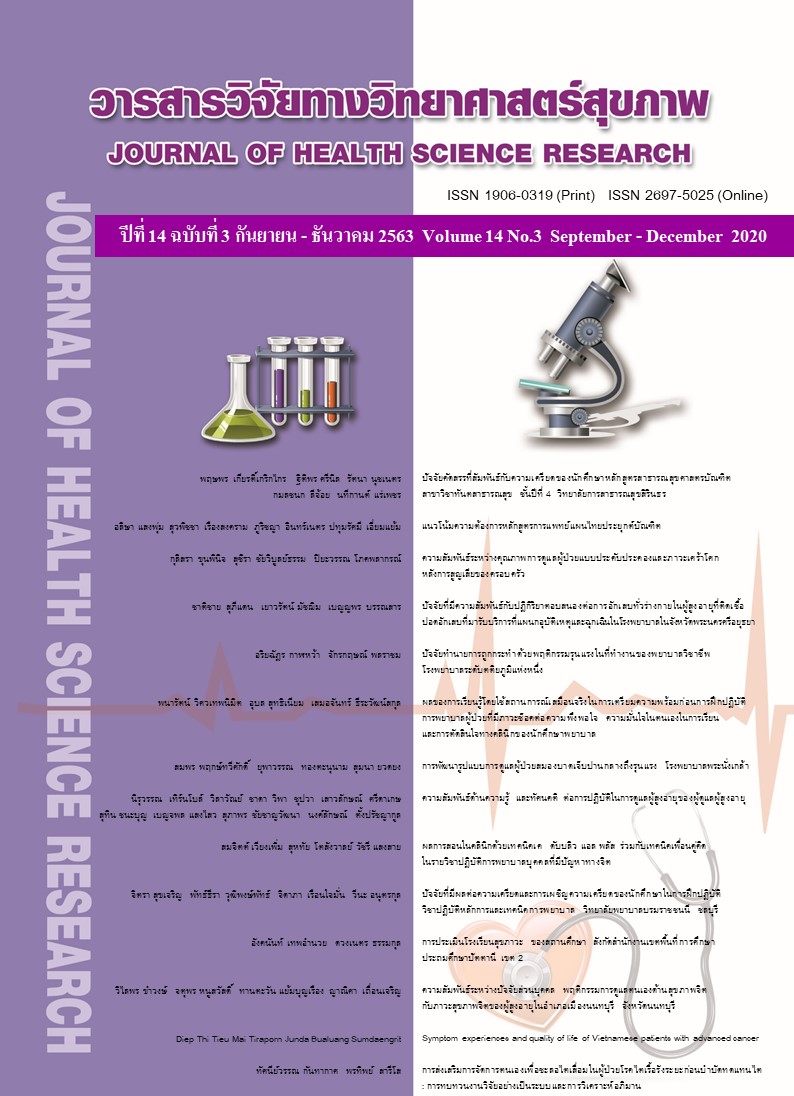ความสัมพันธ์ด้านความรู้ และทัศนคติ ต่อการปฏิบัติในการดูแลผู้สูงอายุของผู้ดูแลผู้สูงอายุ
Main Article Content
บทคัดย่อ
บทนำ : การดูแลสุขภาพผู้สูงอายุมุ่งเน้นการป้องกันไม่ให้ผู้สูงอายุมีการเจ็บป่วยเพิ่มมากขึ้น การจัดระบบการดูแลผู้สูงอายุโดยให้ชุมชนมีกลุ่มเฉพาะที่ดูแลเป็นกำลังสำคัญในชุมชนต่อไป
วัตถุประสงค์การวิจัย : ศึกษาความสัมพันธ์ระหว่างความรู้ และทัศนคติกับการปฏิบัติในการดูแลผู้สูงอายุของผู้ดูแลผู้สูงอายุ ในเขตองค์การบริหารส่วนตำบลโพนงาม อำเภอกมลาไสย จังหวัดกาฬสินธุ์
วิธีการวิจัย : การศึกษาภาคตัดขวางในกลุ่มผู้ดูแลผู้สูงอายุ จำนวน 167 คน โดยใช้แบบสัมภาษณ์แบบมีโครงสร้าง วิเคราะห์ข้อมูลด้วยสถิติเชิงพรรณนา สถิติสัมประสิทธิ์สหสัมพันธ์ของเพียร์สัน และสถิติทดสอบค่าที
ผลการวิจัย : ผู้ดูแลผู้สูงอายุส่วนใหญ่เป็นอาสาสมัครสาธารณสุขประจำหมู่บ้าน รายได้ต่ำกว่า 5,000 บาทต่อเดือน ความรู้เกี่ยวกับการดูแลผู้สูงอายุส่วนใหญ่อยู่ในระดับไม่ดี ทัศนคติเกี่ยวกับการดูแลผู้สูงอายุส่วนใหญ่อยู่ในระดับดี การปฏิบัติในการดูแลผู้สูงอายุส่วนใหญ่อยู่ในระดับดีมาก ความรู้และทัศนคติต่อการดูแลผู้สูงอายุมีความสัมพันธ์เชิงบวกในระดับต่ำกับการปฏิบัติในการดูแลผู้สูงอายุ (r=.215, r=.213, p < .05) ตามลำดับ ผลการเปรียบเทียบด้านความรู้และทัศนคติต่อการดูแลผู้สูงอายุจำแนกตามระดับการศึกษา พบว่า ทั้งสองด้านมีความแตกต่างกันอย่างมีนัยสำคัญทางสถิติ (p < .05) โดยระดับการศึกษาประถมศึกษา และมัธยมศึกษาตอนต้นมีคะแนนเฉลี่ยน้อยกว่าระดับมัธยมศึกษาตอนปลายขึ้นไป
สรุปผล : ความรู้ และด้านทัศนคติต่อการดูแลผู้สูงอายุมีความสัมพันธ์กันกับการปฏิบัติในการดูแลผู้สูงอายุของกลุ่มผู้ดูแล ดังนั้นหน่วยงานที่เกี่ยวข้องควรมีการส่งเสริมและพัฒนาด้านความรู้ ปรับทัศนคติ และคำนึงถึงระดับการศึกษาของผู้ดูแล เพื่อเพิ่มการดูแลสุขภาพผู้สูงอายุอย่างมีประสิทธิภาพ
Downloads
Article Details
บทความที่ได้รับการตีพิมพ์เป็นลิขสิทธิ์ของวิทยาลัยพยาบาลบรมราชชนนี จังหวัดนนทบุรี
ข้อความที่ปรากฏในบทความแต่ละเรื่องในวารสารวิชาการเล่มนี้เป็นความคิดเห็นส่วนตัวของผู้เขียนแต่ละท่านไม่เกี่ยวข้องกับวิทยาลัยพยาบาลบรมราชชนนี จังหวัดนนทบุรี และคณาจารย์ท่านอื่น ในวิทยาลัยฯ แต่อย่างใด ความรับผิดชอบองค์ประกอบทั้งหมดของบทความแต่ละเรื่องเป็นของผู้เขียนแต่ละท่าน หากมีความผิดพลาดใด ๆ ผู้เขียนแต่ละท่านจะรับผิดชอบบทความของตนเองแต่ผู้เดียว
เอกสารอ้างอิง
Department of Older Persons. Report of Eldery in Thailand (77 provinces) [Internet]. Department of Older Persons; 2019 [cited 2020 May 30]. Available from: http://www.dop.go.th/th/know/side /1/1/275. (in Thai).
Office of the National Economics and Social Development Board. Populations Projections for Thailand 2010-2040. Bangkok; 2013. (in Thai).
National Health Security Office. The manual of long term care for the dependent elderly in community (Long term Care) under universal health coverage scheme, Fiscal year 2016. Bangkok; 2016. (in Thai).
Foundation of Thai Gerontology Research and Development Institute (TGRI). Situation of the Thai Eldery 2018. Bangkok; 2018. (in Thai).
Kalasin statistical office. Situation and Perspectives on the Elderly, Kalasin Province 2017 [Internet]. Kalasin statistical office; 2018 [cited 2020 Apr 6]. Available from:http://kalasin.nso.go.th/images/attachments/ Info.News/Info.News2561/009Sep/1004older61up.pdf. (in Thai).
Phon Ngam Chaloem Phrakiat Health Center. Demographic data of people preparing to enter the elderly age 50 - 59 years. Kalasin; 2018. (in Thai).
Ruansri P, Pothiban L, Nanasilp P. Knowledge, Attitudes, and Practices among Health Care Personnel Pertaining to Terminal Care for Older Patients with Chronic Illness. Nursing Journal. 2015; 42(2):24-35. (in Thai).
Bassah N, Ubenoh US, Palle JN. An exploratory study of the knowledge and practices of family caregivers in the care of the elderly at home in the Buea Health District, Cameroon. J Gerontol Geriatr Res. 2018;7(47):2-13.
Dearden C, Becker S. Young carers and education. London: Carers UK; 2003.
Feldt LS. The approximate sampling distribution of Kuder-Richardson reliability coefficient twenty. Psychometrika. 1965;30 (3):357-70.
Santos JR. Cronbach’s alpha: A tool for assessing the reliability of scales. J Ext. 1999;37(2):1-5.
Bloom BS. Taxonomy of educational objectives Vol. 1 Cognitive domain. New York. McKay 1956;20-4.
Best JW. Research in Education Fifth Education. Prentice-Hall; 1986.
Hinkle DE, Wiersma W, Jurs SG. Correlation: a measure of relationship. Applied statistics for the behavioural sciences. 1994 3rded.:105-31. Boston: Houghton Mifflin; 1994.
Department of Health. Guideline for Elderly Care, six edition [Internet]. Department of Health; 2013 [cite 2020 Nov 22]. Available from: http://hpc2.ana mai.moph.go.th/emedia/files/p//135_201 50907131224.pdf.
Eamsamai S, Mhuansit R, Thongmag C. An elderly care model among caregiving volunteers at Phukrang Municipality, Amphur Praputthabat, Saraburi province. Nursing Journal of the Ministry of Public Health. 2012;22(3):77-87. (in Thai).
Miller B, McFall S, Montgomery A. The impact of elder health, caregiverr involvement, and global stress on two dimensions of caregiver burden. J Gerontol. 1991;46(1):9-19.
Locock L, Brown JB. All in the same boat? Patient and carer attitudes to peer support and social comparison in motor neurone disease (MND). Soc Sci Med 2010;71(8):1498-505.
Van LD, Meiland FJ, Van HG, Droes RM. Personalised caregiver support: effectiveness of psychosocial interventions in subgroups of caregivers of people with dementia. Int J Geriatr Psychiatry. 2012;27(1):1-14.
Hoffmann T, Mckenna K, Worrall L, Read SJ. Evaluating current practice in the provision of written information to stroke patients and their carers. Int J Ther Rehabil. 2004;11(7):303-10.


